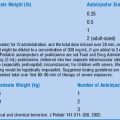Chapter 37 Hematologic and Oncologic Emergencies
HEMATOLOGIC EMERGENCIES
1 How should one approach the evaluation of a child presenting with anemia to the emergency department (ED)?
 Historical features: Rapidity of onset, hemorrhage, diet, history of easy bruising or bleeding, family history of blood disorders
Historical features: Rapidity of onset, hemorrhage, diet, history of easy bruising or bleeding, family history of blood disorders
 Physical examination findings: Jaundice, splenomegaly, enlarged lymph nodes, bruising/bleeding, occult blood on rectal examination
Physical examination findings: Jaundice, splenomegaly, enlarged lymph nodes, bruising/bleeding, occult blood on rectal examination
 Laboratory studies: Complete blood count with manual differential, mean corpuscular volume (MCV), peripheral smear, reticulocyte count, Coombs test
Laboratory studies: Complete blood count with manual differential, mean corpuscular volume (MCV), peripheral smear, reticulocyte count, Coombs test
13 What are considered to be low-risk criteria for outpatient management of febrile patients with SCD?
15 An ill-appearing 6-year-old girl presents with weakness for 2 days. On examination she has jaundice and pale conjunctivae but no bruising or petechiae. Her hemoglobin level is 4 g/dL, but her white blood cell and platelet counts are normal. Her reticulocyte count is 20%. She has unconjugated hyperbilirubinemia, and she has dark-brown urine (which is dipstick-positive for blood but has no RBCs on microscopic examination). This presentation suggests what broad category of anemia?
17 Why is excessive cow’s milk consumption associated with iron-deficiency anemia in young children?
18 Describe appetite abnormalities associated with iron-deficiency anemia
26 How is a suspected hemolytic transfusion reaction initially treated?
ONCOLOGIC EMERGENICIES
27 What are the most common childhood malignancies?
 Leukemia is the most common childhood malignancy, and acute lymphoblastic leukemia (ALL) is the most common type of childhood leukemia.
Leukemia is the most common childhood malignancy, and acute lymphoblastic leukemia (ALL) is the most common type of childhood leukemia.
 The most common solid organ tumors are brain tumors, and most of these tumors are infratentorial. Medulloblastomas and cerebellar astrocytomas are the most common central nervous system tumors in children.
The most common solid organ tumors are brain tumors, and most of these tumors are infratentorial. Medulloblastomas and cerebellar astrocytomas are the most common central nervous system tumors in children.
28 Why are children with malignancies at risk for sepsis?
 Most importantly, there can be replacement of the bone marrow by malignant cells and direct suppression of granulocyte production by chemotherapeutic agents, resulting in neutropenia.
Most importantly, there can be replacement of the bone marrow by malignant cells and direct suppression of granulocyte production by chemotherapeutic agents, resulting in neutropenia.
 Other mechanisms of defense against infection, including mechanical barriers (e.g., intact mucous membranes and skin), cell-mediated and humoral immunity, and splenic function, are frequently impaired in patients with cancer.
Other mechanisms of defense against infection, including mechanical barriers (e.g., intact mucous membranes and skin), cell-mediated and humoral immunity, and splenic function, are frequently impaired in patients with cancer.
 Indwelling central venous catheters, ventriculoperitoneal shunts, and other implanted devices may become sites of infection.
Indwelling central venous catheters, ventriculoperitoneal shunts, and other implanted devices may become sites of infection.
30 An ill-appearing 6-year-old boy with acute myelogenous leukemia presents with fever and right-lower-quadrant abdominal pain. In addition to the usual causes of fever and right-lower-quadrant pain, what other entity needs to be considered in a neutropenic patient?
31 A teenager with a diffuse headache is found to have a white blood cell count of 200,000 cells/mm3. What treatment should be initiated in the ED while awaiting confirmatory studies?
34 What are the presenting symptoms of anterior mediastinal mass?
These symptoms may include stridor, cough, dyspnea, hemoptysis, and orthopnea.
35 How should a patient with an anterior mediastinal mass be studied?
KEY POINTS: METABOLIC DISTURBANCES SEEN IN ONCOLOGY PATIENTS
1 Hyperkalemia: Seen with tumor lysis syndrome
2 Hyperphosphatemia: Seen with tumor lysis syndrome
3 Hyperuricemia: Seen with tumor lysis syndrome
4 Hypercalcemia: Seen in patients being treated with cis-retinoic acid or those with significant bony metastases
5 Hypernatremia: Seen in patients with diabetes insipidus, which can occur frequently in patients with central nervous system tumors or Langerhans cell histiocytosis
6 Hyperglycemia: Seen in patients on steroids or asparaginase
37 A 4-year-old girl with lymphoma presents with shortness of breath. What are some possible causes of her symptoms?
Table 37-1 Causes of Shortness of Breath in Patients with Cancer
| Superior vena cava (SVC) syndrome: Compression or thrombosis of the SVC can cause dyspnea, and may result in facial plethora, jugular venous distention, and headache |
| Superior mediastinal syndrome: Compression of the trachea by tumor; often used interchangeably with SVC syndrome |
| Pleural effusions |
| Pericardial effusion |
| Cardiomyopathy: Commonly associated with anthracycline chemotherapeutics |
| Dysrhythmias: Electrolyte disturbances |
| Pneumonia |
| Pulmonary embolism |
| Anemia |



















































